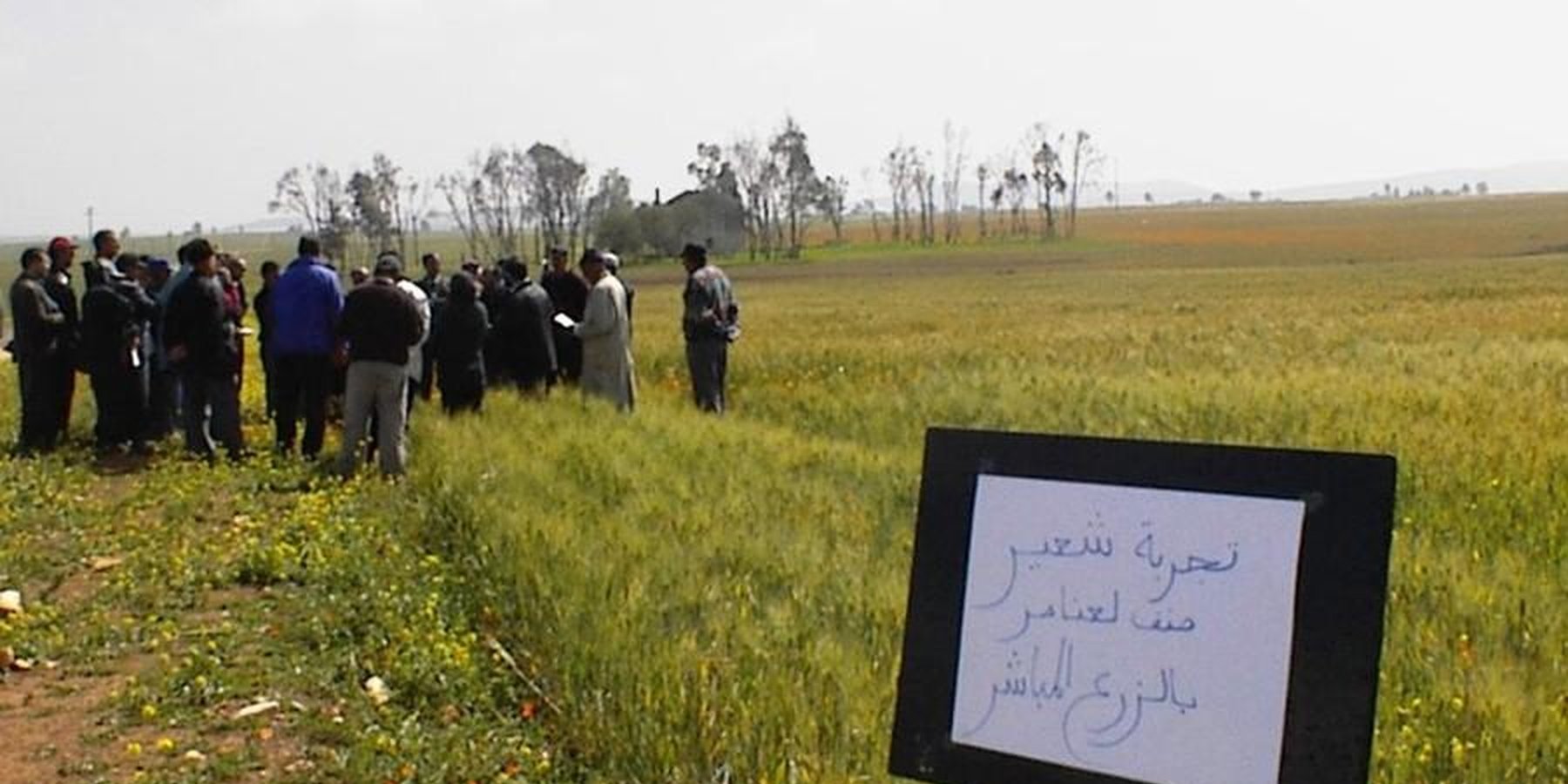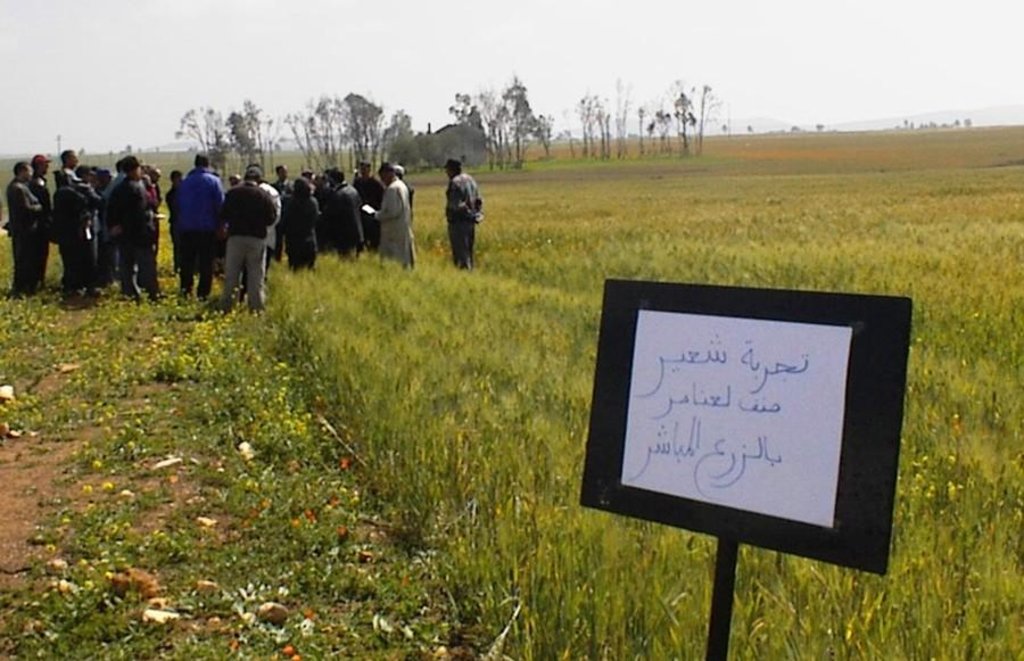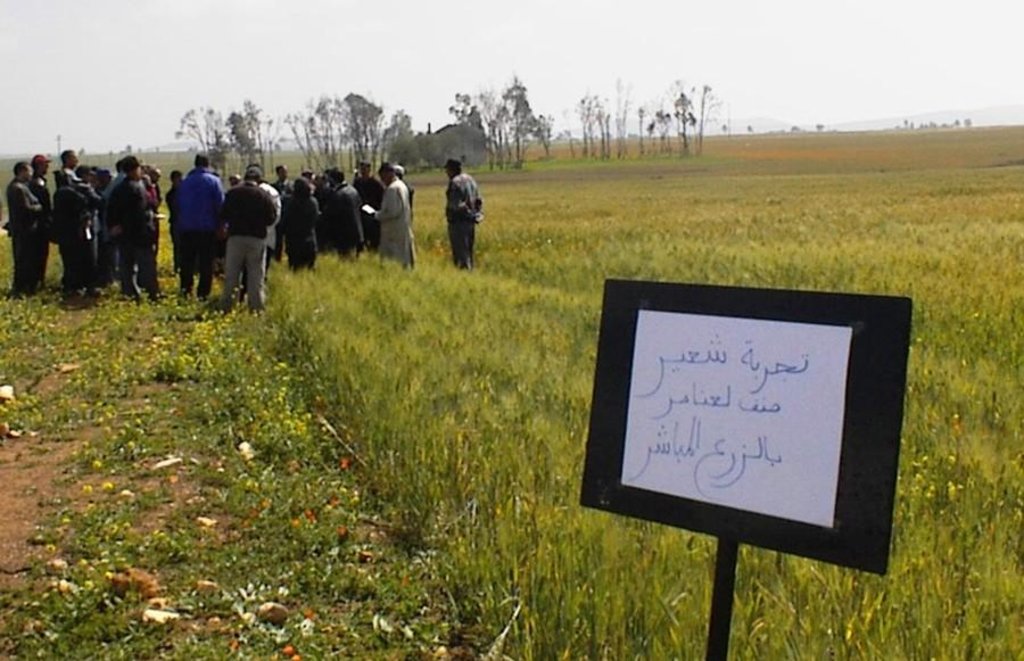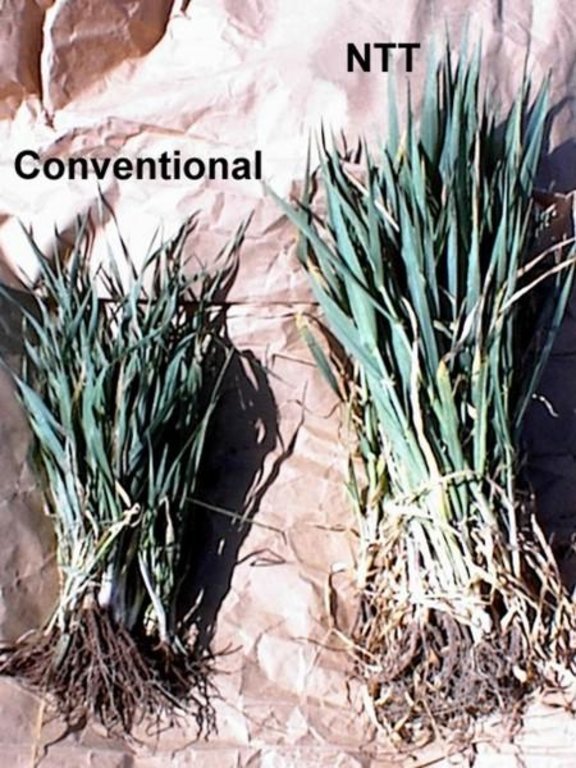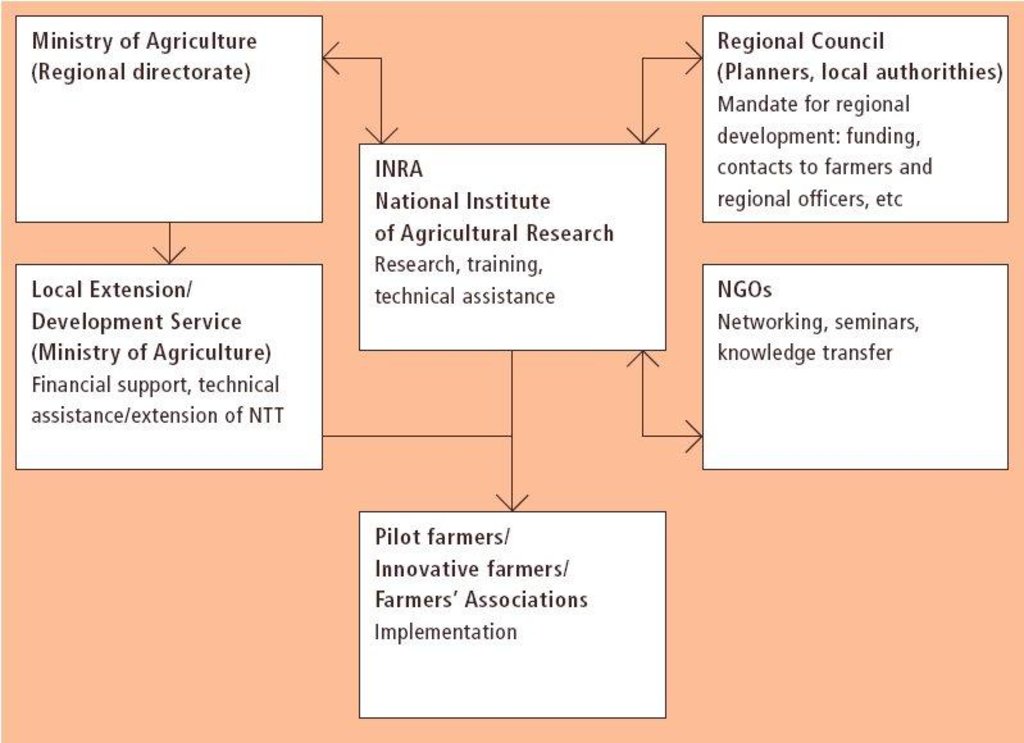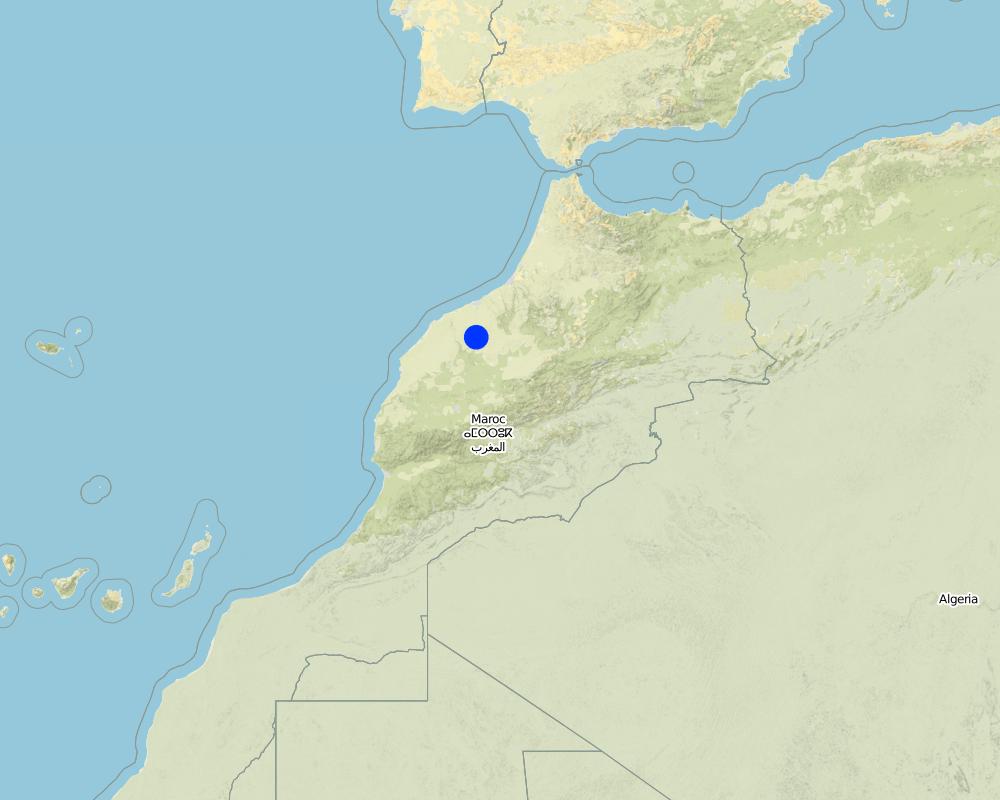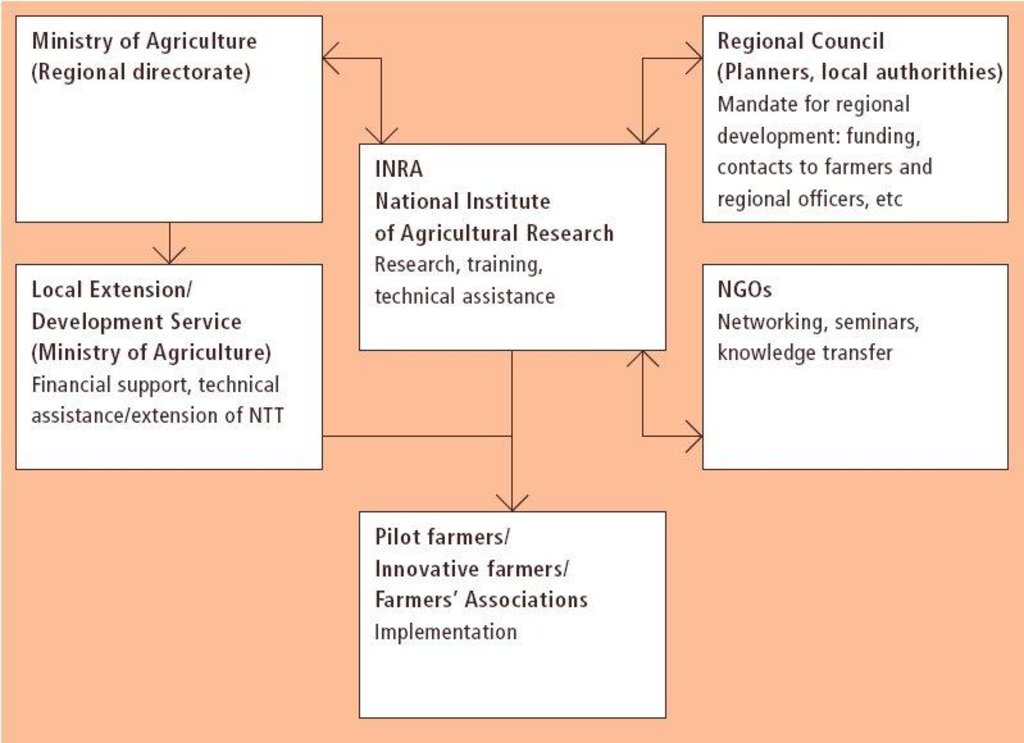Applied research and knowledge transfer [摩洛哥]
- 创建:
- 更新:
- 编制者: Rachid Mrabet
- 编辑者: –
- 审查者: David Streiff, Alexandra Gavilano, Deborah Niggli
approaches_2355 - 摩洛哥
查看章节
全部展开 全部收起1. 一般信息
1.2 参与方法评估和文件编制的资源人员和机构的联系方式
有助于对方法进行记录/评估的项目名称(如相关)
Book project: where the land is greener - Case Studies and Analysis of Soil and Water Conservation Initiatives Worldwide (where the land is greener)有助于对方法进行记录/评估的机构名称(如相关)
Institut National de la Recherche Agronomique Morocco (INRA-Morocco) - 摩洛哥1.3 关于使用通过WOCAT记录的数据的条件
编制者和关键资源人员接受有关使用通过WOCAT记录数据的条件。:
是
1.4 SLM技术问卷的参考
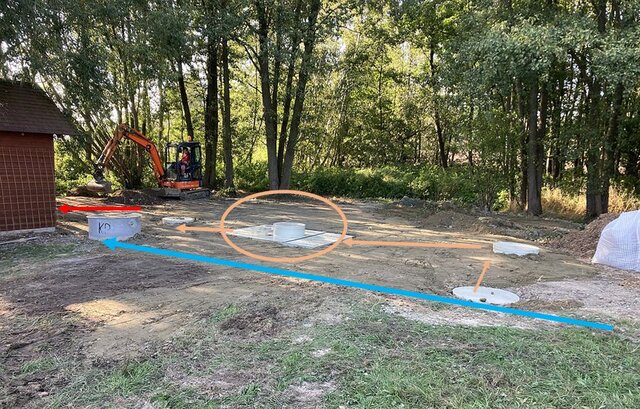
Drainage Biofilter [捷克共和国]
Biofilters or “bioreactors” connected to agricultural tile drains are relatively inexpensive and space-saving measures with considerable potential to improve the quality of drainage water.
- 编制者: Antonín Zajíček
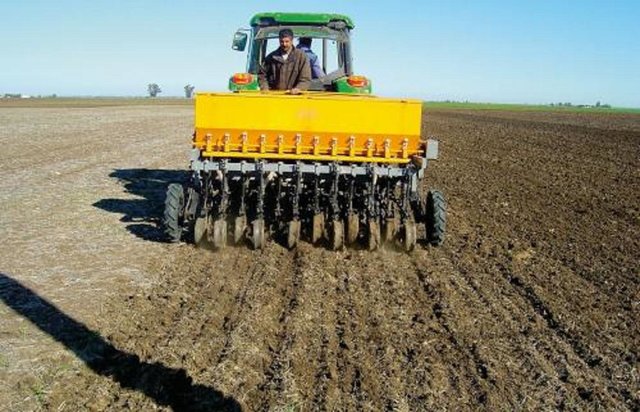
Технология нулевой обработки почвы [摩洛哥]
Система нулевой обработки почвы с использованием растительных остатков для среднемасштабного производства пшеницы и ячменя
- 编制者: Rachid Mrabet
2. SLM方法的描述
2.1 该方法的简要说明
Innovative, cross-disciplinary community-based approach for development and transfer of no-till technology at the farm level.
2.2 该方法的详细说明
该方法的详细说明:
Aims / objectives: After 15 years of on-station research at the National Institute of Agricultural Research (INRA), testing and evaluation of no-till technology (NTT) at farm level started in 1997 with three pilot farmers. Recently two new projects were established to promote the introduction and adoption of NTT, in collaboration with the regional council and extension service of the Ministry of Agriculture (MoA). Fourteen pilot farmers are now involved in NTT. The overall purpose is to promote no-till technology to restore soils, improve production, mitigate drought, increase wealth and strengthen farmers??? organisations. NTT has been shown to be socially, economically and ecologically adapted to the local conditions. The approach has three stages: (1) Initiation: this includes basic research, strategic research and applied research; (2) Consolidation: planning is followed by detailed evaluation of technology adoption on farmers' fields; (3) Maturity: this involves the acceptance/spread of NTT with an increased number of farmers in the future.
Methods: INRA carries out research, information dissemination, gives training to technicians and farmers, and provides both technical assistance and monitoring. The regional council was convinced by the technology and now financially supports research activities, drill manufacture and extension of NTT. It also facilitates contacts with decision makers and farmers, and carries out evaluations. MoA development and extension services provide financial support, advice, technical assistance, and logistical support to farmers: they help to make the drills available. NGOs are engaged in the development of local/regional networks and farmers associations, as well as in funding and providing incentives. Farmers themselves are involved in the implementation, evaluation and dissemination of NTT. Participation, cross-discipline and bottom-up planning are key elements of the approach. Methods for implementation include long-term community on-farm trials, on-site training and information exchange, participation of stakeholders, information dissemination tools, and multi-directional knowledge flow. These are supplemented by intensive measurement/monitoring schemes, establishment of local/regional networks and farmers' association creation. On-the-job training is also provided.
2.3 该方法的照片
2.5 采用该方法的国家/地区/地点
国家:
摩洛哥
区域/州/省:
Chaouia/Ouardigha
Map
×2.6 该方法的开始和终止日期
注明开始年份:
1997
注释:
The approach is now under application in this region but it is expected to apply in other regions of Morocco if funds are available
2.7 方法的类型
- 基于项目/方案
2.8 该方法的主要目的/目标
The Approach focused mainly on SLM with other activities
- spread the no-till technology: thereby enhancing soil productivity and reducing susceptibility to land degradation. - develop the production of no-till drill machinery. - generally: to ameliorate the living conditions of rural people through enhancing expertise, capacities and knowledge of farmers in managing their soils and crops
The SLM Approach addressed the following problems: - previous absence of an integrated research and extension programme. - lack of technical options in a harsh and risky environment. - underlying problems of land degradation and drought periods
2.9 推动或妨碍实施本办法所适用的技术的条件
社会/文化/宗教规范和价值观
- 阻碍
Over-reliance on traditions in soil management; attitudes of farmers towards conventional tillage need challenging through information about alternatives.
Treatment through the SLM Approach: Training, video conferences, travelling workshops, etc.
财务资源和服务的可用性/可得性
- 阻碍
Lack of specific funds, credit, loans for investment in new machinery
Treatment through the SLM Approach: Prioritise funds for no-tillage development
机构设置
- 阻碍
Extension service are not well incorporated in the approach due to lack of knowledge/information on no-tillage
Treatment through the SLM Approach: Special Training program; change of institutional thinking upon no-tillage systems
法律框架(土地使用权、土地和水使用权)
- 阻碍
lack of SWC-relatedl laws
Treatment through the SLM Approach: Recommendations on laws to cover SWC technologies.
The existing land ownership, land use rights / water rights moderately hindered the approach implementation small size of field requires integration of farmers for using no-till drill and other equipment
了解SLM,获得技术支持
- 阻碍
Lack of adapted machinery
Treatment through the SLM Approach: Promotion of no-till drill industry in Morocco
3. 相关利益相关者的参与和角色
3.1 该方法涉及的利益相关者及其职责
- 当地土地使用者/当地社区
- 社区组织
Existing groups of land users
- SLM专家/农业顾问
- 国家政府(规划者、决策者)
INRA
3.2 当地土地使用者/当地社区参与该方法的不同阶段
| 当地土地使用者/当地社区的参与 | 指定参与人员并描述活动 | |
|---|---|---|
| 启动/动机 | 被动 | Mainly:public meetings; partly: workshops/seminars; open days |
| 计划 | 外部支持 | Mainly: workshops/seminars; partly: public meetings |
| 实施 | 外部支持 | Mainly: responsibility for minor steps; partly: casual labour |
| 监测/评估 | 外部支持 | Mainly: interviews/questionnaires; partly: measurements/observations; field observations |
| Research | 互动 | on-farm; demonstration plots |
3.3 流程图(如可用)
具体说明:
Institutional framework: Stakeholders and their roles: cross-disciplinary linkages between INRA, collaborating institutions and farmers.
3.4 有关SLM技术选择的决策
具体说明谁有权决定选择要实施的技术:
- 主要是SLM专家,咨询土地使用者之后
解释:
Recognition of no-tillage as a pertinent technology by decision-makers at local, regional or national level (specialists and politicians / leaders) is due to important station results as well as to international call for promoting this technology
Decisions on the method of implementing the SLM Technology were made by mainly by SLM specialists with consultation of land users. No-tillage technology was under research and on farm trials (3 farmers) and showed very marked benefits, particularly during droughty years
4. 技术支持、能力建设和知识管理
4.1 能力建设/培训
是否为土地使用者/其他利益相关者提供培训?:
是
明确受训人员:
- 土地使用者
- extensionists/trainers, politicians/decision makers, planners
培训形式:
- 在职
- 示范区域
- 公开会议
涵盖的主题:
no-tillage system, weed control, machinery, cropping systems, crop variety
4.2 咨询服务
土地使用者有权使用咨询服务吗?:
是
指明是否提供了咨询服务:
- 在土地使用者的土地上
说明/注释:
Key elements: Participation of extension agents and farmers / observations (on the crop, weeds, disease, seeding condition, yield components), On-job training / open days (field days to make farmers and extension discuss questions / remarks regarding no till technology, Monitoring/Participatory; 1) Advisory service was carried out through: government's existing extension system 2) Advisory service was carried out through: government's existing extension system; Extension staff: mainly government employees 3) Target groups for extension: land users; Activities: demonstration, field days, traveling workshops
Advisory service is inadequate to ensure the continuation of land conservation activities; Extension Agents need training
4.3 机构强化(组织发展)
是否通过这种方法建立或加强了机构?:
- 是,适度
具体说明机构的强化或建立程度:
- 本地
具体说明支持类型:
- 财务
- 能力建设/培训
4.4 监测和评估
监测和评估是该方法的一部分吗?:
是
注释:
Bio-physical aspects were regular monitored by 0 through measurements
Technical aspects were regular monitored by 0 through measurements
Socio-cultural aspects were ad hoc monitored by 0 through observations
Economic / production aspects were regular monitored by 0 through measurements;
Area treated aspects were ad hoc monitored by 0 through observations
No. of land users involved aspects were regular monitored by 0 through measurements
Management of Approach aspects were ad hoc monitored by 0 through observations;
There were no changes in the Approach as a result of monitoring and evaluation: The evaluation is still in process: thus too early to state what changes are likely.
4.5 研究
研究是该方法的一部分吗?
是
明确话题:
- 社会学
- 技术
- agronomy
提供进一步的细节,并指出是谁做的研究:
crop performance, soil analysis, no-till drill design and evaluation, socio-economic indexes of NTT.
Research was carried out both on station and on-farm
5. 融资和外部物质支持
5.1 该方法中SLM组成部分的年度预算
如果不知道准确的年度预算,请给出一个范围:
- 100,000-1,000,000
注释(例如主要的资助来源/主要捐助者):
Approach costs were met by the following donors: government (national - INRA/Ministry): 80.0%; local community / land user(s) (Regional Council): 20.0%
5.2 为土地使用者提供财政/物质支援
土地使用者是否获得实施该技术的财政/物质支持?:
是
5.3 对特定投入的补贴(包括劳动力)
- 设备
| 具体说明哪些投入得到了补贴 | 程度如何 | 对补贴做出具体说明 |
|---|---|---|
| 机械 | 充分融资 | |
- 农业
| 具体说明哪些投入得到了补贴 | 程度如何 | 对补贴做出具体说明 |
|---|---|---|
| 充分融资 | ||
| 充分融资 | ||
| biocides | 充分融资 | |
如果土地使用者的劳动力是一项重要的投入,那么是不是:
- 自愿
5.4 信用
是否根据SLM活动的方法给予信用值?:
是
对条件(利率、回报等)进行具体说明:
repayment conditions: To promote the acceptance of the technology, farmers receive a 50% subsidy on the purchase price of the no-till drill (as is the general case for all types of drills)..
6. 影响分析和结论性陈述
6.1 方法的影响
该方法是否帮助土地使用者实施和维护SLM技术?:
- 否
- 是,很少
- 是,中等
- 是,支持力度很大
Better use of the rainwater stored in the soil by crops leads to improvement of soil and water management: increase in soil organic matter has multiple benefits.
该方法是否改善了阻碍SLM技术实施的土地使用权/用户权问题?:
- 否
- 是,很少
- 是,中等
- 是,支持力度很大
The land is a private property and can not be affected by no-tillage but with no-tillage farmers can rent or buy new lands for adoption of more no-tillage.
Did other land users / projects adopt the Approach?
- 否
- 是,很少
- 是,中等
- 是,支持力度很大
This no-till system can now be considered for several different agroecological situations where a similar approach can be applied (e.g. flood control project, agro-forestry program, soil restoration project, etc.).
6.3 方法活动的可持续性
土地使用者能否维持通过该方法实施的措施(无外部支持的情况下)?:
- 是
若是,请说明如何维持:
Progress can continue to be made, assuming that training, subsidised drills, and the creation of farmers' organisations all persist.
6.4 该方法的长处/优点
| 土地使用者眼中的长处/优势/机会 |
|---|
| Adaptability to farmers needs/constraints (How to sustain/ enhance this strength: Include integration of livestock and crops. This should be helpful to pursue in the approach) |
| Farmer's decisions, opinions, critics (How to sustain/ enhance this strength: Bottom-up maintained (gradually)) |
| Incentives make it possible for land users to experiment with a new cultivation system (How to sustain/ enhance this strength: Diversification of incentives: eg reduction in seed prices and herbicides for NTT farmers; award - NTT best producers; reduction in interest rates for NTT farmers (for credits or loans); special NTT training courses.) |
| 编制者或其他关键资源人员认为的长处/优势/机会 |
|---|
| The NTT project has integrated several institutions -which is unique in Morocco. Now research, extension, community and farmers are working together towards the same objective (How to sustain/ enhance this strength: Further develop, refine and spread NTT) |
| NGOs development: the association of NTT farmers and environmental clubs are important for spreading NTT and for re-enforcing the importance of NTT amongst government officers and decision makers (How to sustain/ enhance this strength: special NGOs should be encouraged to respect soils, nature, environment) |
| Cross-discipline: involving land users, research and extension agents has helped in building up an approach suitable for the local conditions. (How to sustain/ enhance this strength: The working teams received also incentives and recognictions) |
| research connected to extension (How to sustain/ enhance this strength: research should be developed to get continuous measurements/information and to search new indexes and means) |
| Progressive implementation of a 'bottom-up' approach; integration of farmers' decisions, opinions and criticisms (How to sustain/ enhance this strength: Farmers and their association are involved gradually in the approach and their critics, comments, feedbacks respected) |
6.5 该方法的弱点/缺点以及克服它们的方法
| 土地使用者认为的弱点/缺点/风险 | 如何克服它们? |
|---|---|
| Information availability: up to now information and communication on NTT is scarce | intensify training of trainees |
| In some situations (farmers with very low incomes), the need for external inputs such as herbicides, seeds, fertilizers and drills may retard implementation of NTT | Incentives should be maintained for a short period and supplemented by credit systems. |
| 编制者或其他关键资源人员认为的弱点/缺点/风险 | 如何克服它们? |
|---|---|
| Direct incentives: there is always a risk that when eliminating these incentives, farmers will abandon NTT | Eliminate incentives gradually and replace with loans and credits. |
| The programme's duration is currently too short to overcome resistance (to new technology adoption) and to address economic constraints of farmers | A long term programme is needed to increase acceptance among farmers. |
7. 参考和链接
7.1 方法/信息来源
- 实地考察、实地调查
- 与土地使用者的访谈
7.2 参考可用出版物
标题、作者、年份、ISBN:
Wall et al, 2002, Institutional aspects of conservation agriculture, International workshop on conservation agriculture for sustainable wheat production, 14-18, october 2002, Tastikent, Usbekistan
可以从哪里获得?成本如何?
p.wall@cgiar.org
标题、作者、年份、ISBN:
Segry, L.; Bouzinac, S and Pieri, C. 1991: An Approach to the development of sustainable farming systems. World echnical papaer N-2, ISBRAM proceedings 1991
链接和模块
全部展开 全部收起链接

Drainage Biofilter [捷克共和国]
Biofilters or “bioreactors” connected to agricultural tile drains are relatively inexpensive and space-saving measures with considerable potential to improve the quality of drainage water.
- 编制者: Antonín Zajíček

Технология нулевой обработки почвы [摩洛哥]
Система нулевой обработки почвы с использованием растительных остатков для среднемасштабного производства пшеницы и ячменя
- 编制者: Rachid Mrabet
模块
无模块


